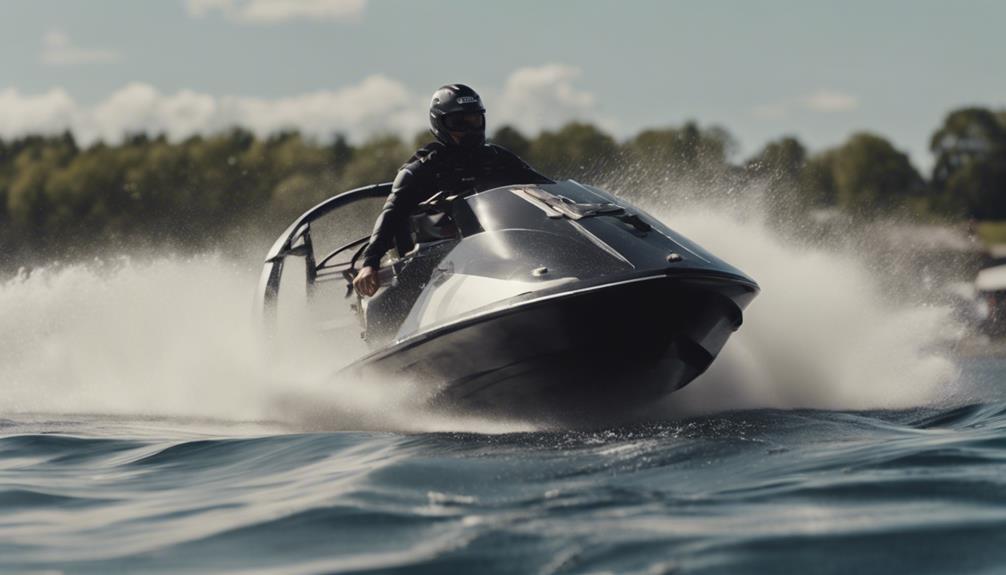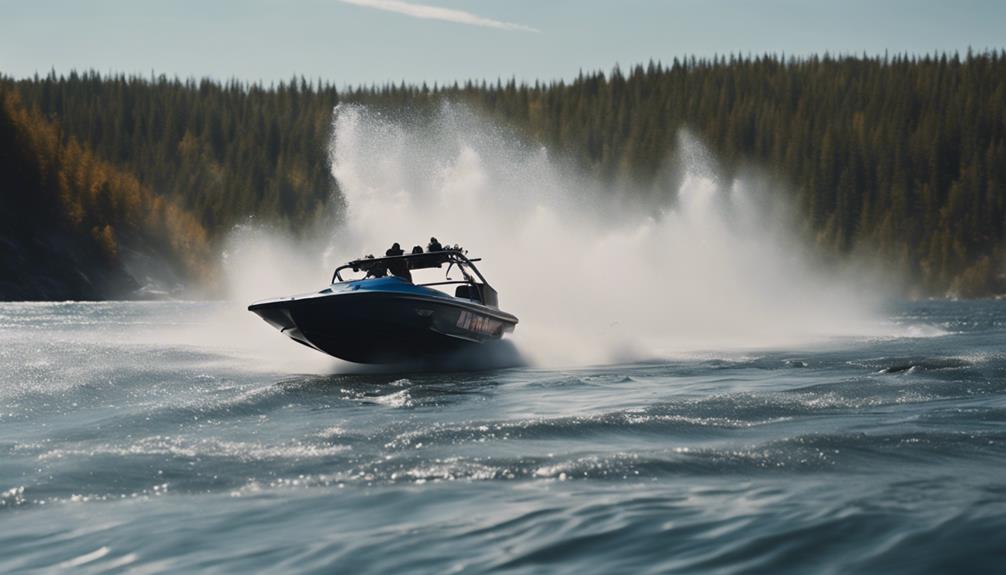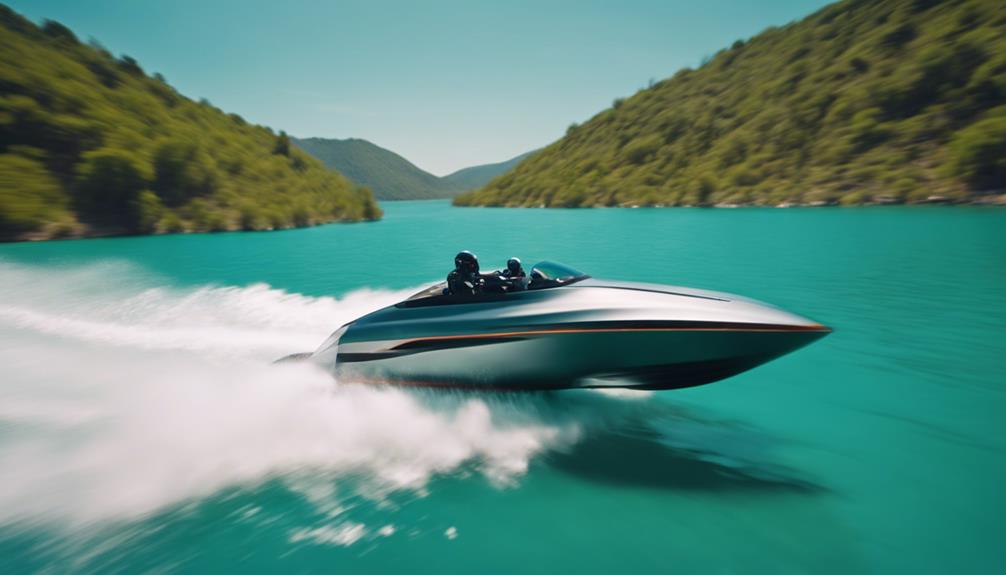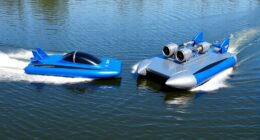Jet boats aren't the top pick for water skiing. Their low-end torque struggles make it tough for quick starts, which are essential for skiing. You'll notice they create a moderate and inconsistent wake, often unsuitable for advanced maneuvers. While jet boats can pull skiers, serious enthusiasts usually prefer traditional towboats for their superior handling and wake shape. That said, if you're after thrills in shallow waters, jet boats offer some excitement. Just remember, for an ideal skiing experience, tuning into specific performance factors can make a big difference. There's more to explore on making the right choice.
Key Takeaways
- Jet boats struggle with low-end torque, making quick starts for water skiing more challenging compared to traditional towboats.
- The wake produced by jet boats is often moderate and inconsistent, unsuitable for serious skiing or advanced maneuvers.
- Traditional towboats provide better stability and wake shape, essential for optimal slalom and trick skiing experiences.
- Jet boats excel in shallow water navigation, but overall performance for towing and skiing lags behind dedicated ski boats.
Jet Boats Vs. Traditional Towboats
When it comes to choosing between jet boats and traditional towboats, you'll find that each type has its own strengths and weaknesses for water skiing.
Jet boats, like Bombardier and Sea Doo models, can pull skiers and wakeboarders, but they generally fall short in performance efficiency compared to traditional towboats. These towboats, such as Mastercraft, are specifically designed for water sports, providing superior wake shape and stability vital for trick skiing and wakeboarding.
One major downside of jet boats is their struggle with low-end torque, which is essential for effective towing. Their power delivery often requires the engine to spool up, making them less responsive when you need immediate acceleration. While jet boats excel in traversing shallow waters, this advantage doesn't outweigh their limitations in skiing performance and wake quality.
The community consensus leans heavily toward traditional towboats for serious skiing and wakeboarding. You'll find they offer better grip and handling characteristics, making them the preferred choice for enthusiasts who prioritize performance on the water.
Ultimately, if you're serious about water skiing, traditional towboats are likely the way to go.
Performance Factors for Water Skiing

Performance factors for water skiing hinge on the boat's ability to deliver low-end torque and produce an ideal wake, both of which greatly impact your skiing experience.
Jet boats, while fun, often struggle with low-end torque, which is essential for effective starts. This deficiency can hinder your performance as you try to get up on your skis.
Additionally, the wake produced by jet boats is typically moderate, making them less favorable for serious water skiing compared to traditional towboats like Mastercraft and Malibu.
If you're considering a jet boat, keep in mind that the performance can vary based on the engine. A three-stage jet or a 351 engine can greatly enhance pulling power compared to lower-powered options.
For peak performance, especially during deep water starts, longer ropes are recommended to minimize turbulent water, which can affect your skiing technique.
Heavier skiers might also need to adjust boat speed and technique to achieve the best results.
Ultimately, while jet boats have their perks, you might find their performance factors less than ideal for serious water skiing.
Wake Shape and Characteristics

Jet boats create a moderate wake that can limit your skiing experience, especially if you're aiming for defined peaks and stability like those offered by traditional towboats. The wake shape produced by these boats isn't as consistent or refined, which can impact your performance while water skiing. You'll likely notice that the peaks are less defined, making it harder to execute advanced maneuvers.
If you're using a jet boat, keep in mind that its wake shape can vary based on the boat's speed and weight distribution. A longer rope, around 75 feet, is often recommended to minimize turbulence during deep water starts, which can help you get up on your skis more smoothly. However, even with adjustments, the wake characteristics from jet boats generally don't meet the standards set by dedicated ski boats.
For serious wakeboarders and slalom skiers, the limitations of jet boats become clear. These enthusiasts typically favor inboard boats designed specifically for ideal wake performance, ensuring they can achieve the necessary conditions for their sport. If your goal is serious water skiing, you might want to reflect on alternatives to jet boats.
Limitations of Jet Boat Design

The design of jet boats inherently limits their effectiveness for water skiing, primarily due to issues like low-end torque and wake shape.
One significant drawback is that jet boats struggle with low-end torque, which is essential for achieving quick hole shots. This slow acceleration can hinder your skiing experience compared to traditional towboats.
Additionally, the wake produced by jet boats often lacks the necessary shape and stability that's ideal for both slalom and trick skiing. You might find that the performance varies greatly, as jet drives rely on high RPMs, making them less reliable for consistent towing.
Another limitation of jet boat design is the absence of lateral plane support, which can lead to sideways movement and compromise stability while pulling skiers.
Because of these factors, many serious water skiers often prefer traditional inboard towboats, like Mastercraft and Malibu, over jet boats.
Community Feedback and Experiences

When it comes to jet boats for water skiing, your experience might vary widely compared to others.
Many users share their thoughts on performance, wake quality, and overall enjoyment, which can help you make an informed choice.
Let's explore what the community has to say about their personal experiences and insights regarding jet boat performance.
Jet Boat Performance Insights
Many enthusiasts agree that while jet boats can pull skiers, their performance often falls short compared to traditional towboats, particularly regarding wake quality and hole shot efficiency.
Jet drives typically struggle with low-end torque, making it challenging to achieve a quick takeoff. This slower hole shot can be frustrating, especially when you're keen to get on the water.
Community feedback highlights that while jet boats can manage to pull skiers, the wake produced isn't ideal for serious skiing or wakeboarding. Users often find that they need to use longer ropes to deal with the turbulent water created during deep water starts, which can further impact skiing performance.
Although jet boats equipped with higher horsepower engines, like a 351, can improve pulling capabilities, they still don't quite measure up to the efficiency and performance of traditional towboats.
User Experiences Shared
User feedback reveals a mixed bag of experiences with jet boats for water skiing, highlighting both their capabilities and limitations compared to traditional towboats.
Many users point out that while jet boats can indeed pull skiers, they often struggle with low-end torque. This makes them less effective for serious water skiing compared to popular towboats like Mastercraft and Malibu.
Community comments frequently mention the less desirable wake shape created by jet boats, which can hinder performance in slalom and trick skiing. Additionally, some skiers note that using longer ropes is necessary to mitigate turbulent water during deep water starts, complicating the skiing experience.
Experienced skiers tend to prefer inboard or I/O setups over jet boats due to their superior grip and handling, especially when it comes to maintaining a straight line while skiing.
Advantages of Jet Boats

Jet boats offer remarkable advantages, particularly their shallow draft, which lets you navigate in as little as 3 inches of water. This makes them perfect for shallow water skiing spots and opens up a world of possibilities for you to explore unique locations that traditional boats can't reach.
Here are some key benefits of using jet boats for your water sports adventures:
- Quick Acceleration: Jet boats plane rapidly, giving you an exhilarating driving experience that enhances your fun on the water.
- Safety First: With no exposed propellers, jet drives considerably reduce the risk of injury to swimmers and skiers, allowing everyone to enjoy the water worry-free.
- Decent Wake Creation: While not as ideal as traditional towboats, jet boats can still create a respectable wake for casual wakeboarding.
- Thrill-Seeking Performance: The unique performance and handling of jet boats cater to those looking for excitement on the water, making every outing memorable.
With these advantages, jet boats stand out as a fantastic choice for water skiing enthusiasts who seek adventure and safety.
Disadvantages of Jet Boat Usage

While jet boats have their perks, you'll notice some significant downsides when water skiing.
The wake shape often isn't ideal, which can impact your skiing experience, and handling challenges can make towing tricky.
If you're serious about perfecting your skills, these factors are worth considering.
Wake Shape Limitations
Producing wakes that are inconsistent and less stable, jet boats can greatly hinder your water skiing performance. The wake shape generated by these boats doesn't provide the best conditions for serious skiers. Here are four key limitations to take into account:
- Inconsistent Wakes: Jet boats often produce wakes that vary considerably, making it tough for skiers to predict their movements.
- Lack of Stability: The absence of lateral plane support means the wakes are unstable, which can throw off your balance.
- Poor Slalom Conditions: These boats fail to generate the clean and well-defined wakes needed for effective slalom skiing.
- Interference from Jet Skis: If you're using jet skis alongside jet boats, their wakes can make it harder to maintain a straight line while skiing.
For ideal skiing experiences, traditional towboats like Mastercraft and Malibu are preferred due to their superior wake shape and stability.
If you're serious about water skiing, it's wise to take these wake shape limitations of jet boats into account before hitting the water.
Handling Challenges During Towing
Handling a jet boat during towing can present several challenges that affect your overall skiing experience.
Unlike prop-driven boats, jet boats often struggle with low-end torque, making it difficult to achieve an effective hole shot. You might find that the jet drive requires time to spool up, leading to delayed acceleration when you need that initial pull for deep water starts.
Moreover, jet drives have less grip on the water, which can compromise your ability to maintain a straight line while towing. This lack of grip creates handling challenges, especially at low speeds, making docking and maneuvering a bit unpredictable. You may notice that the absence of lateral plane support in jet boats makes them prone to sideways movement during towing activities, which can lead to instability.
These factors combined can result in a less controlled and enjoyable experience while skiing. If you're considering using a jet boat for towing, be prepared to adapt your techniques and possibly face some frustrating moments on the water.
Ultimately, while jet boats offer unique advantages, their handling challenges during towing mightn't align with your skiing needs.
Best Practices for Jet Boat Skiing

To guarantee a smooth water skiing experience with a jet boat, always use a longer rope—around 75 feet—to reduce turbulent water during deep water starts. This distance helps ascertain your skier has a better launch. Remember, the performance of your jet boat can be influenced by the skier's weight, so adjust accordingly.
Here are some best practices for jet boat skiing:
- Choose the right jet boat: Opt for a model with a higher horsepower engine, like a three-stage jet and a 351 engine, for ideal pulling power.
- Understand low-end torque: Jet boats may struggle with low-end torque, which means you might experience a slight delay in acceleration. Be patient as the engine spools up.
- Practice your handling: Jet boats require different driving techniques compared to traditional towboats, especially at low speeds. Spend time familiarizing yourself with the controls.
- Monitor conditions: Keep an eye on water conditions and adjust your speed and techniques to ascertain a safe and enjoyable experience.
Following these guidelines will enhance your jet boat skiing adventures, providing a fun and thrilling ride!
Frequently Asked Questions
What Are the Downsides of Jet Boats?
Jet boats have several downsides. You'll notice poor wake shape, limited low-end torque for quick starts, and increased maintenance due to debris issues. Plus, they can feel unstable, making it hard to maintain a straight line.
Can You Waterski off a Jet Ski?
Yes, you can waterski off a jet ski, but it's not ideal. The unstable platform makes it tough to maintain a straight line, and the performance generally lags behind traditional towboats.
Are Jet Boats Good in Rough Water?
Jet boats can struggle in rough water. While they have quick acceleration and maneuverability, you might find their handling less stable compared to traditional boats, especially when the conditions get choppy or unpredictable.
Can a Jet Boat Pull a Skier?
Imagine you're on a sunny lake, enthusiastic to ski behind a jet boat. Yes, a jet boat can pull a skier, but it may struggle with performance compared to traditional ski boats, especially during deep starts.
Can Yamaha Jet Boats Be Used for Water Skiing?
Yes, Yamaha jet boats can definitely be used for water skiing. Their powerful engines and superior handling make for an exhilarating water skiing experience. With the ultimate yamaha jet boat reliability, you can count on a smooth and enjoyable ride every time you hit the water for some water skiing fun.
Conclusion
To sum up, while jet boats can offer a thrilling experience, they mightn't be the best choice for water skiing due to their wake and design limitations.
Imagine carving through pristine waters behind a powerful towboat, feeling the perfect pull and smooth glide beneath you. Isn't that the ultimate exhilaration you crave?
Ultimately, consider your skiing style and preferences when choosing the right boat, ensuring you get the best out of your time on the water.









